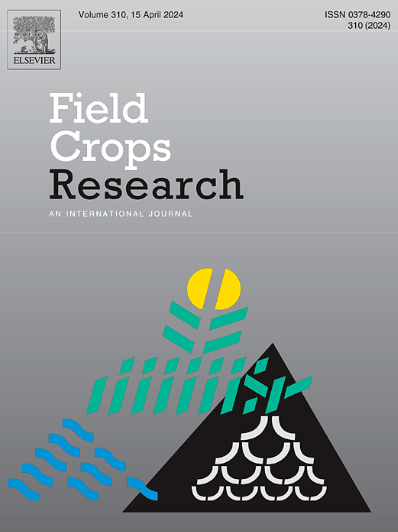Foliar application of nano carbon dots increases grain yield in rice via enhancing leaf photosynthesis and stem assimilates translocation under nitrogen deficiency
IF 5.6
1区 农林科学
Q1 AGRONOMY
引用次数: 0
Abstract
Context
Rice is one of the world's most important food crops, and the excessive use of fertilizers to achieve high rice yields has led to global environmental concerns. Therefore, it is critical to reduce nitrogen fertilizer input, a problem for which nano carbon dots (NCD) provide a promising solution. However, few studies have examined the effect of NCD on rice yield formation under reduced nitrogen input conditions.
Objectives
The aim of this study is to evaluate the effects of NCD on the photosynthetic characteristics, accumulation and translocation of stem assimilates, and yield of rice under reduced nitrogen conditions.
Methods
A two-year field experiment was conducted on rice using two varieties, Yongyou2640 and Y liangyou2, with five treatments: N1 (270 kg N ha−1), N2 (216 kg N ha−1), N3 (162 kg N ha−1), CN2 (216 kg N ha−1+foliar application of NCD), and CN3 (162 kg N ha−1+ foliar application of NCD). Leaf photosynthetic enzyme activity, stem and grain starch synthesis-related enzyme activity, sucrose translocation-related enzyme and gene expression, and yield and yield components were measured at five time points from the jointing stage to maturity.
Results
Under the condition of reducing nitrogen fertilizer by 40 %, the foliar application of NCD could significantly increase rice yield, with average increases of 13.2 % and 12.3 % for both varieties in 2022 and 2023, respectively, reaching the yield achieved with normal nitrogen levels. The foliar application of NCD significantly increased the leaf photosynthetic rate by increasing rubisco enzyme activity, resulting in a 8.5–61.5 % increase in the photosynthetic rate for both varieties at different growth stages across the two years. In addition, the foliar application of NCD prior to heading increased the stem activity of ADP-glucose pyrophosphorylase (AGP) and starch synthase (StS), thereby increasing the accumulation of NSC in the stems before flowering. The average increases for both varieties were 21.2 % and 17.8 % in 2022 and 2023, respectively. After heading, the activities of α-amylase, β-amylase, and sucrose phosphate synthase (SPS) in the stems, as well as the activities of AGP, StS, and cell wall invertase in the grains, were significantly increased. The expression of key genes involved in sucrose phloem loading in the stem, OsSUTs and OsSWEETs, and genes related to sucrose phloem unloading in the grains, OsSUTs, OsSWEETs, and OsCINs, were upregulated, thereby promoting the translocation of assimilates from the stems to the grains, which improved the grain filling percentage and consequently increased the grain yield under conditions of nitrogen deficiency.
Conclusion
In summary, under conditions of nitrogen deficiency, the foliar application of NCD to rice can increase the activities of photosynthetic enzymes, starch metabolism enzymes in stems and grains, and sucrose translocation-related enzymes; increase sucrose translocation-related gene expression; regulate the accumulation and translocation of assimilates; and improve grain filling and grain yield, and also increase economic profit.
在缺氮条件下,叶面施用纳米碳点通过促进叶片光合作用和茎同化物转运而提高水稻产量
水稻是世界上最重要的粮食作物之一,为了实现水稻高产而过度使用化肥已经引发了全球环境问题。因此,减少氮肥的投入至关重要,纳米碳点(NCD)为解决这一问题提供了一个有希望的解决方案。然而,在减少氮素投入条件下,很少有研究考察非传染性疾病对水稻产量形成的影响。目的研究低氮条件下NCD对水稻光合特性、茎同化物积累和转运以及产量的影响。MethodsA两年田间试验对水稻使用两个品种,Yongyou2640和Y liangyou2,与五个治疗:N1(270 公斤 N公顷−1),N2(216 公斤 N公顷−1),N3(162 公斤 N公顷−1),CN2(216 公斤 N公顷−1 +叶面应用非传染性疾病),和c·N³(162 公斤 N公顷−1 +叶面非传染性疾病的应用)。在拔节期至成熟期的5个时间点测定叶片光合酶活性、茎和籽粒淀粉合成相关酶活性、蔗糖易位相关酶及基因表达、产量及产量成分。结果在氮肥减量40% %的条件下,叶面施用NCD可显著提高水稻产量,2022年和2023年两个品种的平均增产幅度分别为13.2 %和12.3 %,达到正常施氮水平下的产量水平。叶面施用NCD通过提高rubisco酶活性显著提高了叶片光合速率,两年内两个品种不同生育期的光合速率均提高了8.5-61.5 %。此外,抽穗前叶面施用NCD提高了茎中adp -葡萄糖焦磷酸化酶(AGP)和淀粉合成酶(StS)的活性,从而增加了花前茎中NSC的积累。这两个品种在2022年和2023年的平均增幅分别为21.2% %和17.8% %。抽穗后茎秆中α-淀粉酶、β-淀粉酶和蔗糖磷酸合成酶(SPS)活性以及籽粒中AGP、StS和细胞壁转化酶活性均显著升高。在缺氮条件下,茎秆中参与蔗糖韧皮部装载的关键基因OsSUTs和OsSWEETs以及籽粒中与蔗糖韧皮部卸载相关的基因OsSUTs、OsSWEETs和OsCINs的表达上调,促进同化物从茎秆向籽粒转运,提高了籽粒灌浆率,从而提高了籽粒产量。综上所述,在缺氮条件下,水稻叶面施用NCD可提高茎秆和籽粒中光合酶、淀粉代谢酶和蔗糖转运相关酶的活性;增加蔗糖易位相关基因的表达;调节同化物的积累和转运;提高籽粒灌浆和产量,增加经济效益。
本文章由计算机程序翻译,如有差异,请以英文原文为准。
求助全文
约1分钟内获得全文
求助全文
来源期刊

Field Crops Research
农林科学-农艺学
CiteScore
9.60
自引率
12.10%
发文量
307
审稿时长
46 days
期刊介绍:
Field Crops Research is an international journal publishing scientific articles on:
√ experimental and modelling research at field, farm and landscape levels
on temperate and tropical crops and cropping systems,
with a focus on crop ecology and physiology, agronomy, and plant genetics and breeding.
 求助内容:
求助内容: 应助结果提醒方式:
应助结果提醒方式:


